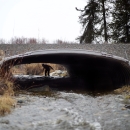States
MaineThis project will modernize fish passage fish passage
Fish passage is the ability of fish or other aquatic species to move freely throughout their life to find food, reproduce, and complete their natural migration cycles. Millions of barriers to fish passage across the country are fragmenting habitat and leading to species declines. The U.S. Fish and Wildlife Service's National Fish Passage Program is working to reconnect watersheds to benefit both wildlife and people.
Learn more about fish passage at Woodland Dam on the St. Croix River in the St. Croix watershed. The existing 1960’s era fishway at this site is too small, poorly designed, limits fish migration, and is a safety hazard. Over the years, three dams along the lower St. Croix River have limited fish populations to less than 1% of their historic levels. Installing a new state-of-the-art fishlift will benefit the American eel, American shad, alewife and blueback herring, as well as downstream endangered Atlantic and shortnose sturgeon. This project is result of collaboration with local Tribal and non-Tribal communities.
Project Quick Facts:
| Project Status | In Development |
| Location | ME, Washington County |
| NFPP Project Funding | $2,000,000 |
| Restoration Techniques | Fishway Replacement |
| Accomplishments | 600 Stream Miles Reopened |
| Partner Project Lead | Maine Department of Marine Resources |
The National Fish Passage Program combines technical expertise with a track record of success.
Implemented primarily through the Service's Fish and Wildlife Conservation Offices, the National Fish Passage Program provides financial and technical assistance to partners across the country. Since 1999, the program has worked with over 2,000 local communities, Tribes, and private landowners to remove or bypass over 3,400 barriers to fish passage and reopen access to over 61,000 miles of upstream habitat for fish and other animals. Staff have expertise in fish migration and biology as well as financial, engineering, and planning assistance to communities, Tribes, and landowners to help them remove barriers and restore rivers for the benefit both fish and people.
Fish passage project proposals can be initiated by any individual, organization, government, or agency. However, proposals must be submitted and completed in cooperation with a Fish and Wildlife Conservation Office. (Please note that fish passage projects being used for federal or state compensatory mitigation or required by existing federal or state regulatory programs are not eligible for funding through the National Fish Passage Program.)
CONTACT A FISH PASSAGE COORDINATOR IN YOUR AREA TO GET STARTED.


